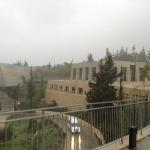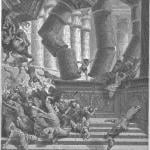 Dr. Daniel Gurtner, Associate Professor of New Testament at Bethel Seminary, is one of my favorite up-and-coming scholars. He also happens to be another Gordon-Conwell Theological Seminary grad and he went on to study at St. Andrews for his PhD (one of the few schools I had applied to). He has kindly agreed to be interviewed in this series on publishing your thesis as a monograph. As a personal note, when I started my PhD I downloaded Dan’s CV and stuck it to my wall – he became my benchmark. His career (especially as a younger scholar) is already impressively distinguished in regards to publishing. Thus, I am happy to have his advice and experience in this interview.
Dr. Daniel Gurtner, Associate Professor of New Testament at Bethel Seminary, is one of my favorite up-and-coming scholars. He also happens to be another Gordon-Conwell Theological Seminary grad and he went on to study at St. Andrews for his PhD (one of the few schools I had applied to). He has kindly agreed to be interviewed in this series on publishing your thesis as a monograph. As a personal note, when I started my PhD I downloaded Dan’s CV and stuck it to my wall – he became my benchmark. His career (especially as a younger scholar) is already impressively distinguished in regards to publishing. Thus, I am happy to have his advice and experience in this interview.
NKG: SNTSMS needs no introduction. It is often hailed as the premier NT monograph series, especially for those of us who studied in the UK. What it your first choice? I know they only publish a few monographs a year – did you see yourself taking a risk (time-wise) in going with them, since you would have to wait for the assessment for quite a while and, if negative, turn elsewhere?
SNTSMS was my top choice by far. I had a list of other publishers in mind, and planned to work my way down the list if I was rejected by CUP. I really did not see this as taking a risk, as the ‘payoff’ for being in the SNTSMS was, in my estimation, well worth the effort. I thought it best to avoid trying a dissertation series, and wanted to see if my work could stand in a monograph series first. Obviously, I am pleased that in the estimation of the reviewer and editor, it did.

My examiners gave no advice about publication. Prof. Bauckham, my supervisor, along with a few others, suggested I try SNTS first. The real ‘perks’ for me going with SNTS was the reputation of the series. I knew that if I got ‘in’ with them, my work would be read and taken seriously.
3. Did you do many changes to the thesis before sending it to Cambridge?
Very few. My examiners were very gracious and I found I had only a few hours of corrections to make.
4. How much work was it to modify the thesis as a result of the SNTSMS reader’s comments? Were they optional?
I had very little to modify there, also. This was actually very interesting. The reader introduced himself to me while we were both at Tyndale House. It was Don Hagner. Dr. Hagner was very supportive of my work, and made a small suggestion on how I introduce the subject at the start of the book. I do not recall if it was mandatory or not, but I felt Dr. Hagner’s comments were so helpful that I adopted them eagerly and they greatly improved the book.
5. It is my understanding that with Cambridge, you don’t do the typsetting. Is that right? Was there any cost involved on your part?
No, there was no cost and I did none of the typesetting. I worked with a company they hire to do the final typesetting and proofing. They were remarkably efficient and careful with my work. I made the indices myself, which they showed me how to do. Their acquisitions editor at the time, Kate Brett, was very professional. She met with me at SBL and walked me through the process.
6. How long did it take for your original manuscript to get accepted?
I was very pleased that it was probably about 3 months. Prof. John Court, editor of the series, was very responsive and kept me informed of its status.
7. How long did you spend working on the manuscript between getting the reader’s comments and seeing the book in print?
I would estimate about a year, perhaps slightly less. As I said, the time I spent on editing the manuscript was minimal. It took the typesetters some time to format the whole thing, as I had quite a few technical arguments, references, charts and diagrams. They corresponded with me via email and by phone with many detailed questions about various pieces of the book.
8. Was it difficult to cut the manuscript down to their required limit?
No, it was not difficult. My thesis word limit at St. Andrews was 100,000 words, and that was the limit for the SNTSMS also. There were a few charts I had to drop, but otherwise there was nothing to do in terms of length.
9. How many free copies of the book do you get? Did you sell any on ebay! (Just kidding)
I cannot recall for sure. I think it was six. I didn’t sell any on ebay, though I do hope to retain any movie rights! And, I gained a title with my friend Mike Bird as “The Curtain Guy.” Seriously, I was happy to have the copies, as there were a number of people who were supportive of my PhD work to whom I was able to present copies in gratitude for their support.
10. Looking back, would you have done anything different with regard to how you went about publishing your thesis?
I am very pleased that I would not change a thing. I attribute this to getting excellent advice ahead of time. Proverbs 15:22 proved true: “Plans fail for lack of counsel, but with many advisers they succeed” (NIV). I asked around about the best publishers first, and then I sent it to my top choice. Prof. Court was very responsive, and CUP does an excellent job. They were very professional and courteous, even though this was my first substantial book. I had a very positive experience. This is not always the case with one’s first serious book, so I am particularly grateful.
11. Lastly, do you mind sharing with my readers what writing projects you have on your table?
My table is full! I am finishing proofs on Second Baruch: A Critical Edition of the Syriac Text for T&T Clark, which should be in print for SBL this November. I am nearly complete with full-length commentary on LXX Exod called Exodus: A Commentary on the Greek Text of Codex Sinaiticus, which is part of Brill’s Septuagint Commentary Series, and should be out in 2010. I am editing a collection of papers called This World and the World to Come: Soteriology in Early Judaism, to be published with Library of Second Temple Studies (T&T Clark, 2011). There are numerous other smaller items on tap, but I intend to occupy the next few years on a commentary on Matthew for a new critical commentary series with Brill.











